This guide walks you through 13 best practices that separate AI success stories from expensive failures.
From training your team to collaborate with AI, to embedding ethical guardrails, to mining customer conversations for market insights.
Here, you’ll get practical, proven strategies you can apply right now to make AI your competitive advantage in customer experience.
1. Always Provide a Clear Path to a Human Agent
One of the biggest mistakes companies make when implementing AI in customer service is creating a system where customers are forced to interact exclusively with bots or automated flows.
While AI can handle a large portion of routine inquiries efficiently, it’s not designed to cover every possible scenario.
For example, those that require empathy, complex judgment, or nuanced problem-solving. Customers know this, and they’re quick to notice when they’re stuck in an endless ‘AI loop’ without a way to reach a real person. This frustration can overshadow any benefits your AI system provides and damage your brand’s reputation.
Another example is this OpenAI customer stuck in a ‘chatbot hell’ with no possibility of reaching a live support agent [*].
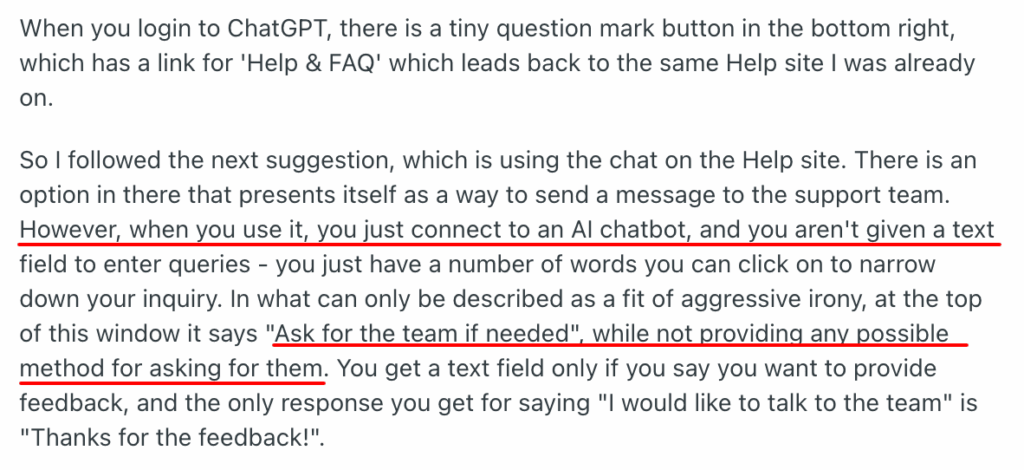

Luckily, some users are finding ‘interesting’ ways to connect to human agents, but you can always make it easier.

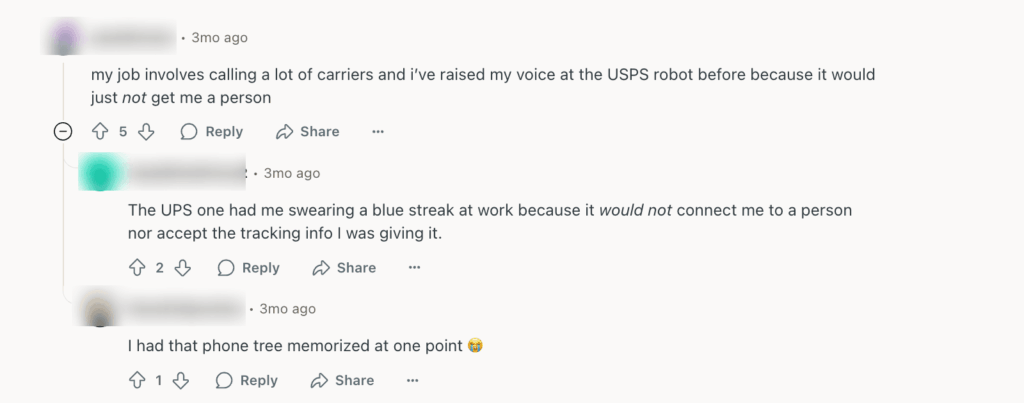



A better solution would be creating a clear path to human agents. That means your AI interface (whether it’s a chatbot, voice assistant, or self-service portal) should make it obvious how and when the customer can connect to a live representative.

This should not be buried behind multiple prompts or hidden under obscure menu options. Instead, the hand-off process should feel seamless: the AI collects necessary context (name, order number, issue description), passes it to the agent, and ensures the customer doesn’t have to repeat themselves.
Read Case Study → How Terra Kaffe improved their CSAT scores (90+) by switching to Kustomer
2. Train Your Team to Collaborate with AI
A common pitfall when introducing AI into customer service is positioning it—intentionally or unintentionally—as a replacement for human agents. This breeds resistance, anxiety, and underutilization of the technology.
A recent case is the viral video of a new AI company running a billboard ad claiming to replace human support agents with AI. Let’s just say it was not so well received by the general public [*].

So it comes as no surprise when reports show that 41% of Gen Z and Millennial employees admit to ‘sabotaging’ their company’s AI adoption strategy. And 1 in 10 workers say they’re tampering with performance metrics to make it appear AI is underperforming [*].
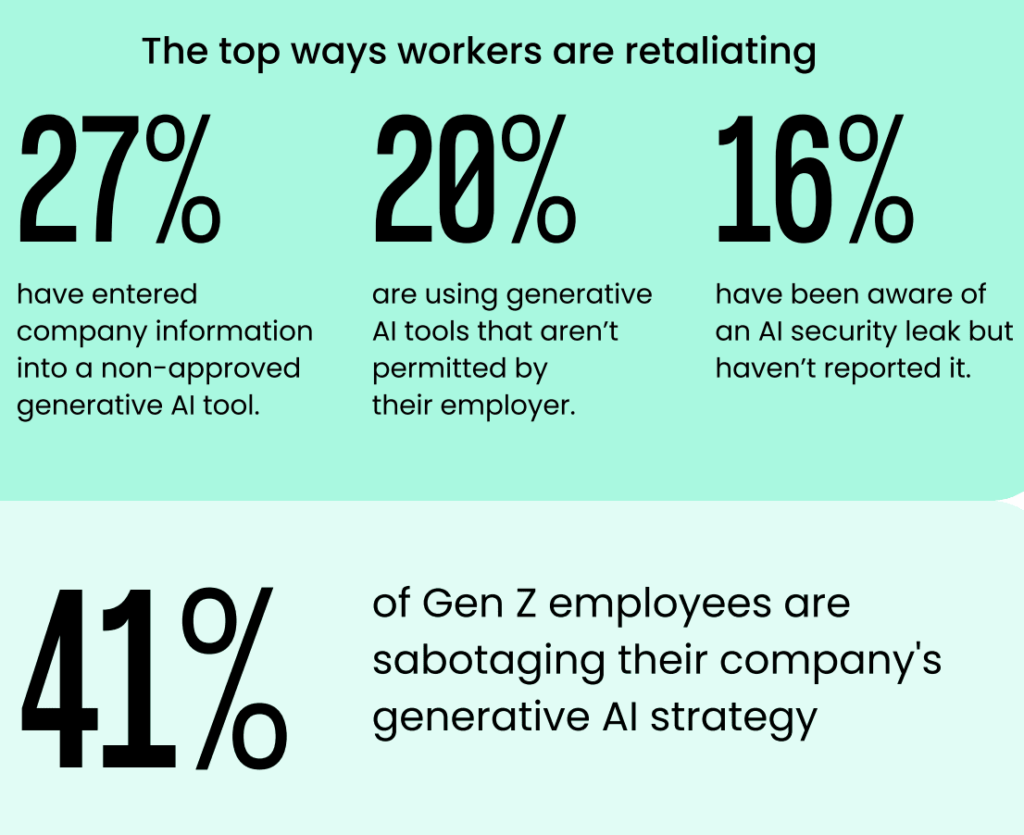
The verdict on who to blame is still uncertain: Employees for not following the trend of adopting new tools? Or executives for a poor integration process?
On the flip side, a better solution is framing artificial intelligence as an agent’s co-pilot. In this case, a tool that amplifies their capabilities in delivering faster, more accurate, and more personalized support.
Here’s the famous menswear brand, UntuckIT integrating live human agents + AI in their customer service.
First chat with their automated chatbot system:

Rerouted to human support agent to handle the issue:

Read Case Study → How popular menswear brand increased agent productivity by 25%

3. Maintain a Single Source of Truth for Your AI
AI systems are only as good as the data they’re trained and fed on. In fact, they follow the common GIGO (Garbage In, Garbage Out) principle [*].
In simple words, if your AI is drawing from multiple, uncoordinated, unverified data sources, the results will be inconsistent, poor, and even misleading.
We saw it in the case of Moffatt v. Air Canada, where a passenger was misled by the airline’s AI chatbot into buying a full-price ticket after he was initially promised a discount.
A single source of truth (SSOT) means unifying all your customer data, product information, and knowledge base into one verified repository that every AI-powered tool references. This could be a centralized CRM, a customer data platform (CDP), or a well-integrated service desk platform that aggregates data from every touchpoint.
The aim here is to ensure that your chatbot, virtual assistant, and agent-assist tools all operate on the same facts, no matter the channel or interaction type.
| 💡PRO TIP → Establish governance by assigning clear ownership for updating and maintaining the SSOT so changes are verified and rolled out quickly. You should also audit your existing data to identify where your AI currently pulls information from, and map gaps, overlaps, and inconsistencies. |
Read the Guide → Beyond Chatbots: Applying AI in CX
4. Leverage Sentiment Analysis to Prioritize High-Stakes Conversations
When it comes to high-volume customer service environments, you can’t (or shouldn’t) treat every incoming query the same. A customer reporting a broken login link isn’t the same as a VIP client threatening to cancel their multi-year contract.
This is where sentiment analysis gives your AI the ability to detect emotional tone and urgency in customer communications, allowing you to automatically prioritize and route conversations that could have the highest business impact.
Here’s how it works:
- Sentiment analysis uses AI technologies like natural language processing (NLP) and machine learning algorithms on incoming chats, emails, call transcripts, or even social media mentions.
- It looks at word choice, tone, punctuation, and conversation patterns to assign a sentiment score: positive, negative, or neutral.
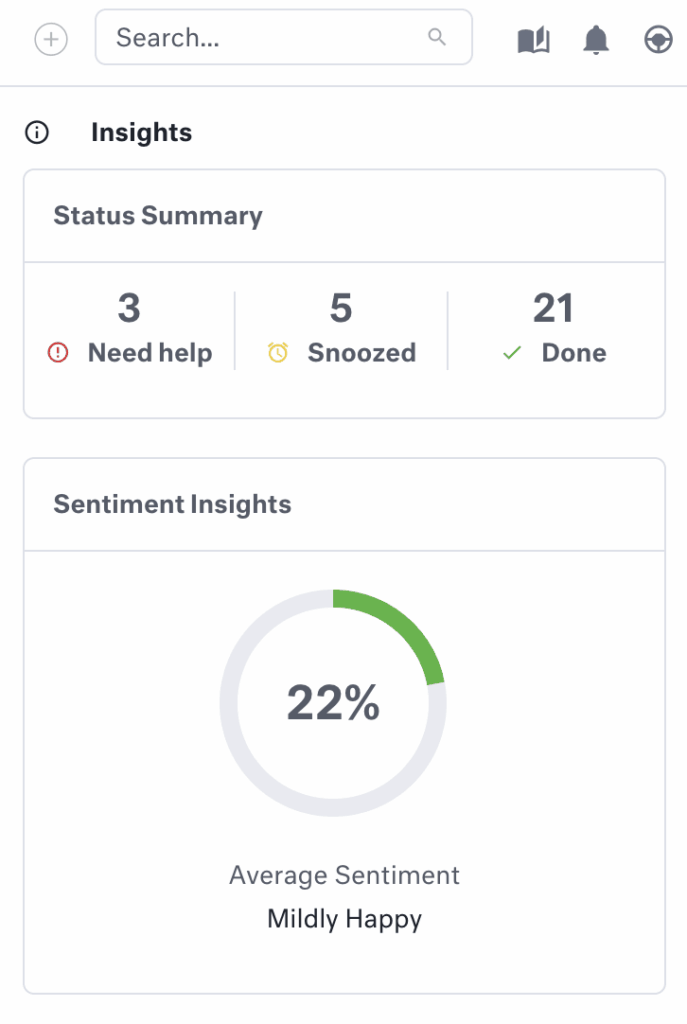
This real-time classification means a high-value customer expressing dissatisfaction on chat doesn’t get lost in a queue behind routine questions.
| 💡Pro Tip → For sentiment analysis to be truly effective, it should integrate with your ticket routing and escalation workflows. That way, when the AI detects high-risk sentiment, it automatically: - Pushes the ticket to the top of the queue. - Assigns it to the most qualified agent (e.g., senior support rep or retention specialist). - Provides a quick emotional context summary so the agent can approach the conversation with the right tone and solution mindset. |
5. Personalize Every Interaction at Scale
Personalization in customer service used to mean inserting a first name into an email or remembering a past order.
But lately, it’s been redefined to understanding each customer’s context, preferences, and history, then tailoring every touchpoint accordingly, across every channel, all in real time.
The Next in Personalization report by McKinsey further proves this as 71% of customers expect the businesses to know them as individuals and their interests [*]. Customers in this survey define their idea of personalization as—
“Thoughtful touchpoints such as checking in post-purchase, sending a how-to video or asking consumers to write a review generate positive brand perceptions.”
But that’s a tricky aspect for businesses with thousands to millions of customers to do without sacrificing accuracy or empathy.
AI makes this possible by combining customer profile data, behavioral insights, and historical interaction records into a unified view. It then uses this information to guide responses, recommend next actions, and surface relevant offers.
For example, say a repeat customer contacts an e-commerce fashion retailer’s chat support about a missing order. Before the agent even replies, AI pulls their past purchase history, notes their preference for express shipping, and identifies that they’ve recently engaged with the brand’s new collection on social media.
The agent greets them by name, apologizes for the delay, offers an express re-ship, and includes a discount on an item they viewed online last week.

Explore AI Agents for Customers →
6. Use Predictive Analytics for Proactive Customer Support
You can’t wait for problems to happen before you react. It’s in fact a losing strategy. Because by the time a customer reaches out with a complaint, the damage to their experience, and potentially your brand—has already occurred.
Using predictive analytics solves this as it leverages historical data, machine learning algorithms, and real-time behavior tracking to forecast potential issues before they escalate.
Here’s how it works:
- Data collection across multiple touchpoints: It gathers data from your CRM, website usage, app activity, product telemetry, and previous support interactions.
- Pattern recognition: The trained AI models detect signals of potential dissatisfaction.
- Risk scoring: Next, it assigns “health scores” to customers based on engagement, usage, and satisfaction indicators, flagging those at risk of churn.
- Automated alerts: The system notifies agents or triggers workflows when certain thresholds are met. E.g., when a high-value client’s engagement drops by 40% in a week.
- Proactive outreach: The agents contact customers with personalized solutions, educational content, or preventive maintenance before the problem worsens.
✨ Kustomer of the day ✨
How HopSkipDrive Anticipates Customer Needs With Kustomer Analytics

HopSkipDrive, a tech-enabled rideshare service for kids, had a major challenge. Their CX data lived in silos, making it difficult to manage communication across CareDrivers, parents, and schools.
This fragmentation meant tracking key performance metrics like CSAT and First Contact Resolution were a hassle.
They needed a platform to centralize all their interactions in order to get actionable predictions for future performance.
Kustomer delivered exactly that. By unifying all channels into an omnichannel timeline view, HopSkipDrive’s CX team could instantly see the full context of a customer’s history.
With better insights into conversation patterns and service outcomes, the team could spot recurring issues earlier, anticipate high-priority cases, and resolve them faster.

7. Be Transparent with Customers About AI Use
AI-powered customer service can deliver faster responses, smarter routing, and more personalized support. However, it can also raise questions about trust, privacy, and authenticity.
In a panel of 32 experts in artificial intelligence, the majority (84%) agree that companies should be required to disclose their use of AI in product offerings to customers [*].

Customers want to know who or what they’re interacting with, and being upfront about AI’s role can make the difference between a positive, trust-building interaction and a negative, alienating one.
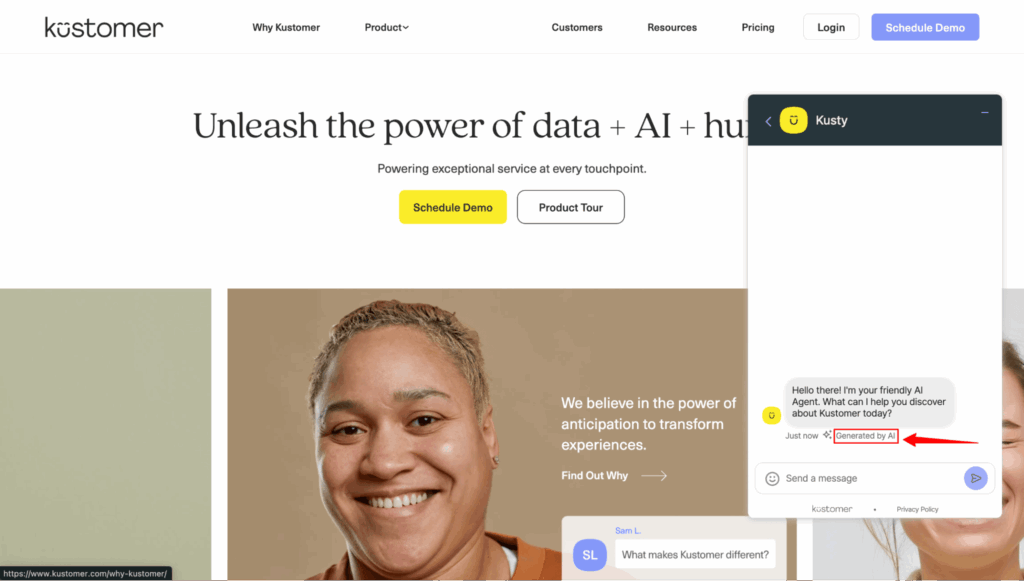
For example, if your chatbot is handling the first stage of support, let customers know:
“You’re chatting with our AI assistant, who can help with most questions and connect you to a human if needed.”
This simple statement immediately clarifies the interaction and positions the AI as a helpful partner rather than a hidden replacement for human service.
Related → 7 Benefits of Using AI in Customer Service
8. Continuously Monitor and Optimize AI Performance
Deploying AI in customer service is an ongoing ‘updating’ process. While your AI model might be great at launch, its performance will naturally fluctuate.
This may be due to evolving customer needs, changes in your product or service, and even shifts in language or cultural context. Without continuous monitoring, these changes can go unnoticed until they start hurting customer satisfaction.
Monitoring AI performance involves tracking a blend of technical and customer-facing metrics.
- Technical metrics like precision, recall, and intent recognition accuracy reveal how well the AI is interpreting customer queries.
- Customer-facing metrics like average response time, First Contact Resolution (FCR), Customer Satisfaction (CSAT), and Net Promoter Score (NPS) show how effectively the AI contributes to a positive customer service experience.
Optimization on both ends here means using the performance data to streamline processes and drive improvements.
This can be retraining the model with better datasets, refining conversation flows, or adjusting escalation rules.
For example, if analytics reveal that the AI struggles with complex refund queries, you can feed it more refund-related data, simplify its dialogue trees, or trigger earlier handoffs to human agents for these cases.
9. Actively Solicit Feedback from Agents and Customers
While performance metrics and analytics are essential, they don’t always give accurate reasons behind an AI’s successes or failures.
This is where direct input from agents and customers bridges that gap. It gives you the qualitative insights necessary to refine both the AI and your broader customer service strategy.
- From the agent’s perspective, feedback reveals where the AI is helping or hindering their workflow.
- For example, an agent might notice that the AI is consistently providing outdated troubleshooting steps, or that it escalates cases too late. These insights can only come from professionals who interact with the system under real operational pressure.
- From the customer’s perspective, feedback uncovers how AI interactions feel on the receiving end.
- Did the conversation feel helpful and human-like, or robotic and frustrating?
- Did the AI understand the intent right away, or did it keep asking irrelevant questions? [*]

Customers will often point out issues that analytics alone can’t detect, such as tone mismatches, confusing responses or a switch to unrelated context.
💡PRO TIP → Create Structured Feedback Loops
- For agents: Provide an easy in-platform way to flag AI errors, confusing responses, or repetitive customer queries.
- For customers: Add quick customer feedback prompts after AI interactions (e.g., thumbs up/down (👍/👎) with optional comments).
10. Use AI to Manage Your Knowledge Base
A knowledge base (KB) is only as valuable as its freshness, accuracy and accessibility. But that’s also the problem in keeping them relevant as products, policies, and customer expectations change.
This is where you need AI to continuously scan your KB for gaps, redundancies, and outdated references, flagging articles that need attention before they cause problems.


For example, if a pricing structure or a product feature changes, AI can detect inconsistencies between your KB content and the latest company updates. This ensures you aren’t giving customers contradictory or obsolete guidance.
Beyond maintenance, AI can also identify emerging trends in customer queries and recommend new articles or sections.
Let’s say AI detects a spike in support tickets related to a recently launched feature. It can automatically draft an initial article outline for review, pulling from ticket transcripts, product release notes, and internal documentation.
✨Feature Highlight ✨
You can use the knowledge base report on Kustomer to understand how each article is performing. This also gives you insights into whether customers are getting answers to their support requests or not.

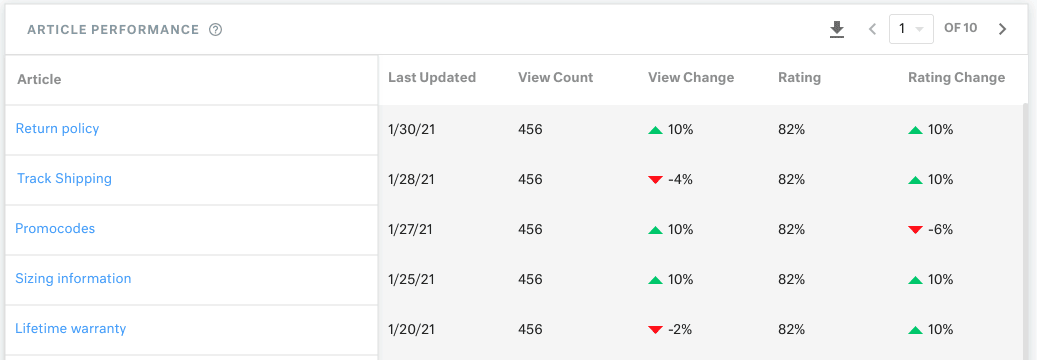


11. Turn Your Support Team into a Revenue Driver
The general idea of customer support has always been that it’s a ‘cost center’—a necessary function for resolving issues but not a contributor to revenue.
Contrary to that opinion, AI can help your support team cross-sell, upsell, and keep existing customers without compromising the quality of service.
The logic is simple: every support interaction builds stronger customer relationships.
Most times, customers are more engaged with support than with sales, especially when they’re actively using your product or service.
With AI, you can analyze past customer interactions, purchase history, usage data, and intent signals in real time to surface contextual recommendations during a conversation.
This means that while an agent solves a customer’s problem, AI can suggest the most relevant upgrade, add-on, or complementary product that fits the customer’s situation and stage in the lifecycle.
For example, if AI detects that a customer is consistently hitting the limits of their current subscription plan, it can prompt the agent to mention a higher-tier plan, tailored to that customer’s usage pattern.
Similarly, AI can monitor customer sentiment and loyalty signals; if a customer shows high satisfaction scores over time, that’s an opportunity to introduce premium features or multi-year contract options.

Read Case Study → How switching to Kustomer allowed Daily Harvest to scale operations and maintain high CSAT scores + a 10% increase in weekly revenue
Related → Support is the new sales: How AI-enhanced reps are driving revenue growth
12. Ensure AI Supports Omnichannel
Customers don’t care what channels they use to initiate a conversation. However, they expect the conversation to continue seamlessly—whether they start on email, switch to live chat, reply via SMS, or mention your brand on social media.
Unfortunately, most businesses are multi-channel, not omnichannel. Yes, they have multiple channels to interact with customers but it’s not synced. This leads to repetitive questions, disconnected experiences, and frustrated customers who feel like they’re starting from scratch every time they reach out.
AI fixes this, but only if it’s designed for omnichannel support. That means your AI system should be able to ingest, process, and act on data from every single customer touchpoint in real time.
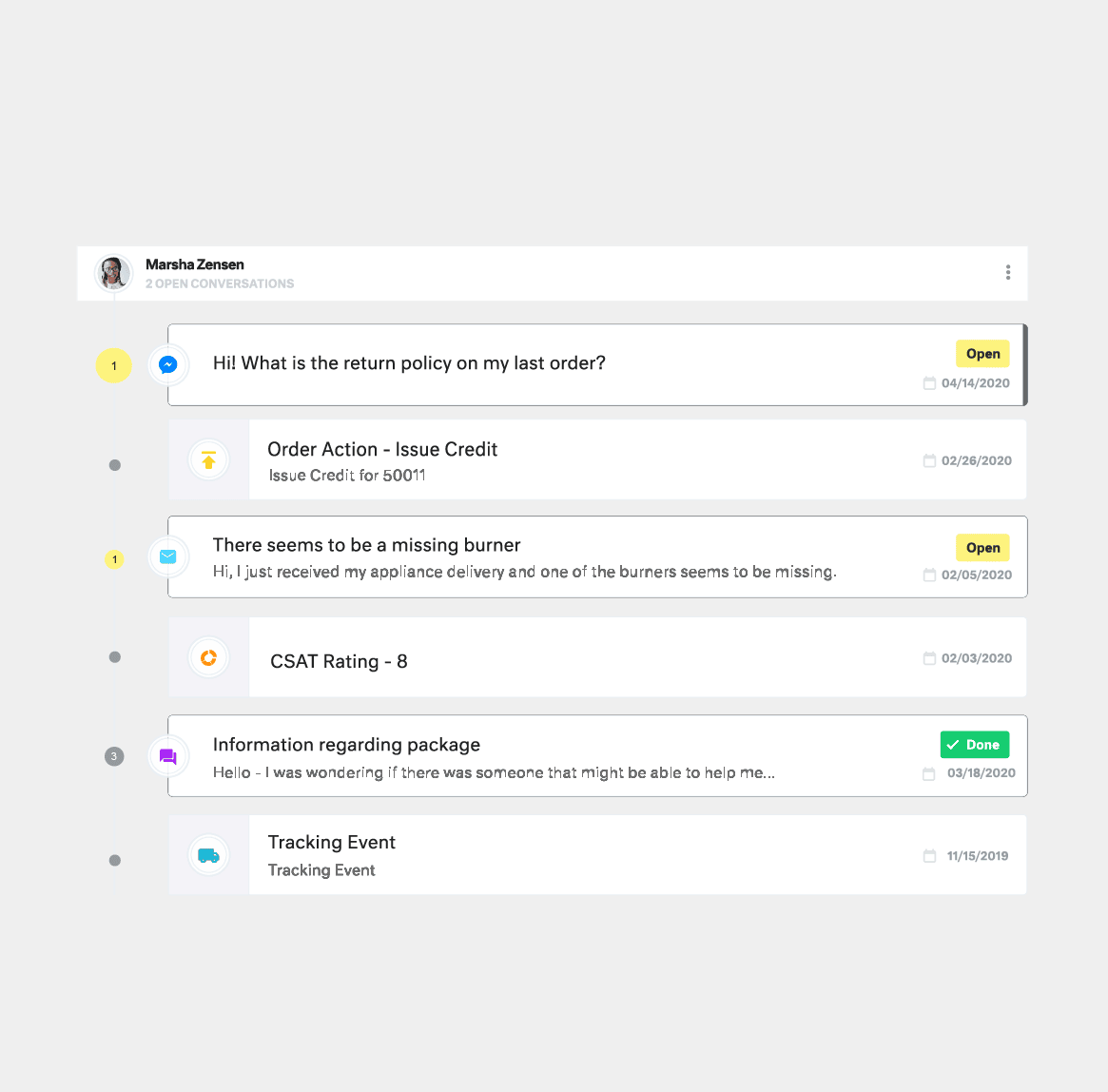
For example, if a customer tweets about a delivery delay, then emails your team the next day. The AI should recognize it’s the same customer, pull up the full conversation history (including the social media exchange), and provide the agent with the context to respond intelligently.
Without this, you’re essentially running multiple isolated “mini support teams” instead of one unified support operation, limiting scalability.

Read Case Study → How Fast growing sock company, COMRAD, switched to Kustomer for an increase in AOV by 26%
13. Embed Ethical Guardrails and Bias Monitoring Into AI Operations
Most AI customer service strategies focus on three things: speed, personalization, and efficiency. But only a few address the ethics of automated decision-making.
AI models are trained on historical data, which means they can inherit and sometimes amplify biases in language, tone, or prioritization.
In customer service, that can manifest as AI giving preferential treatment to certain customer profiles, misinterpreting sentiment from expressions, or producing inconsistent service levels across demographics.
A good solution is building a framework that continuously checks your AI for fairness, transparency, and compliance with regulations like GDPR, CCPA, and other generative AI governance laws.
You can start by defining what “fair” means in your context: should all customers receive identical wait times regardless of channel? Should sentiment analysis weigh certain emotional cues equally across languages and cultures?
Then, implement measurable standards and auditing tools to track whether your AI meets those standards.
AI You Can Trust. Service Your Customers Will Love

That’s exactly what Kustomer AI delivers, every day, through:
- Real-time intent detection: Instantly identifies why a customer is reaching out so agents can respond with precision from the first message.
- Unified customer timeline: Puts every interaction, purchase, and note in one view, so context is never lost between channels.
- Smart conversation routing: Automatically directs inquiries to the best-fit agent or bot, reducing handoffs and resolution times.
- Knowledge base automation: Keeps your help content fresh and relevant by spotting gaps and updating articles based on recurring customer needs.
With Kustomer AI, it’s all about creating support experiences your competitors can’t match. Faster resolutions, more engaged customers, happier agents, and a support operation that learns and improves with every interaction.
Every Great Brand Has Great Support. Yours Can Too
Talk to sales →
FAQs: AI Customer Service Best Practices for 2025
What are the benefits of AI in customer service?
AI in customer service offers several key benefits:
- 24/7 availability: AI-powered chatbots and self-service options provide instant answers to customers around the clock.
- Increased efficiency: Automating repetitive and routine tasks frees up customer service agents to focus on complex, high-value customer issues.
- Faster resolutions: AI can instantly diagnose common problems and provide immediate solutions.
- Operational cost savings: It allows you to handle a higher volume of inquiries without adding more staff.
- Enhanced personalization: AI can use customer data to tailor interactions and recommendations at scale.
What are some examples of AI in customer service?
AI is used in many practical applications within a support environment. Common examples include:
- Intelligent chatbots: Answering frequently asked customer questions and handling simple customer requests on your website or in-app.
- Agent-assist tools: Providing real-time response suggestions, conversation summaries, and relevant knowledge base articles to human agents during live chats.
- Smart routing: Automatically categorizing incoming support tickets and routing them to the right agent or department based on language, topic, or sentiment.
- Sentiment analysis: Monitoring the emotional tone of customer messages to flag urgent or negative conversations for immediate attention.
What are some simple ways to use AI to improve customer service?
You don’t need to overhaul your entire operation to see benefits. Some simple, high-impact ways to start include:
- Automate your top 3-5 most common questions (like “What’s my order status?”).
- Use an AI-powered chatbot to handle inquiries and collect customer information when your live agents are offline.
- Implement an agent-assist tool to automatically summarize long conversation threads for your customer service team.
How to get started with AI in customer service?
You can start using AI in customer service by following these steps:
- Set a clear goal: Define the problem you want to solve, such as reducing first response time or improving resolution rates.
- Pick a high-impact use case: Begin with a repetitive task that takes up a lot of your team’s time.
- Prepare your knowledge base: Keep help center content accurate and up to date so AI has reliable information to work with.
- Choose the right platform: Select AI tools that integrate seamlessly with your CRM and helpdesk.
- Run a pilot test: Start small, track performance, and optimize before rolling out to all customers.
What to consider when implementing AI-powered customer service?
When rolling out AI-powered customer service, focus on these key factors:
- Human handoff: Ensure there is always a seamless and easy path for a customer to escalate from an AI to a human agent.
- Team training: Train your agents on how to collaborate with AI tools so they see it as a helpful assistant.
- Data quality: The AI’s effectiveness is directly tied to the quality and accuracy of the knowledge you provide it.
- Transparency: Be upfront with customers when they are interacting with an AI to build trust and manage expectations.
How to measure the performance of AI in customer service?
You should track specific KPIs to measure the ROI and effectiveness of your AI tools. Key metrics include:
- Ticket Deflection Rate: The percentage of customer inquiries resolved by AI without any human involvement.
- Escalation Rate: The percentage of conversations that start with AI but need to be transferred to a human agent.
- Customer Satisfaction (CSAT): Survey customers after an AI-driven interaction to gauge their satisfaction.
- First Contact Resolution (FCR): The rate at which AI can resolve a complex issue in a single interaction.
- Average Handle Time (AHT): Measure the reduction in time for human agents who are using AI-assist tools.
What is the future of AI in customer service?
The future of AI in customer service is focused on creating more seamless and intelligent experiences.
Here are some trends to watch out for:
- Hyper-personalization: AI will use real-time data to create unique, tailor-made service journeys for every customer.
- Advanced emotion AI: Systems will become much better at understanding subtle emotional cues, tone, and intent in conversations.
- Conversational AI: Voice bots will become nearly indistinguishable from human agents, making phone support more fluid.
- Tighter governance: Ethical considerations and data privacy regulations (like the EU AI Act) will play a much larger role in how AI is deployed.




